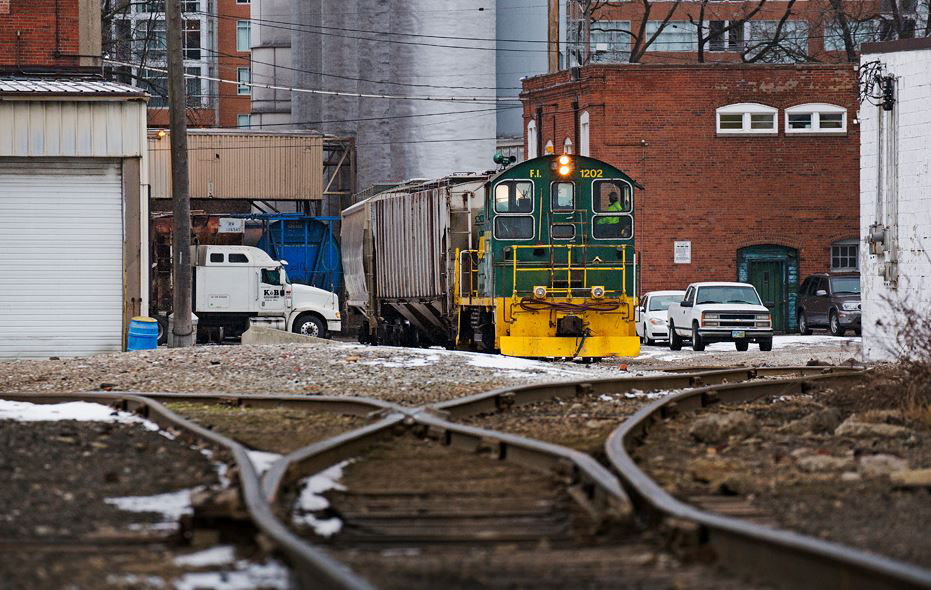
Switchers are resilient: Less than 4% of Electro Motive Division SW- and MP-series switching locomotives manufactured between 1966 and 1987 remain in use on Class I railroads today. Of the more than 2,900 locomotives built in those 20 years, TRAINS calculates less than 12 SW and approximately 100 MP switchers still earn revenue for Class I railroads today. Big railroads have parted ways with the switcher, preferring younger and higher-horsepower GP siblings, which Class I railroads still possess in abundance.
Even though these locomotives aren’t an ideal fit for Class I railroads, they are far from irrelevant in the industrial, terminal, and short line scene. Lessors and contract switching companies bolster their rosters with these locomotives at every opportunity, as their characteristics make them attractive for industrial work.
Switchers occupy a niche void in industrial railroading. As Class I railroads divest, SWs and MPs are sold into the aftermarket at prices more affordable than a Trackmobile and with a horsepower rating more effective than a railcar mover without the extra muscle offered by GPs. Whether at steel mills, grain elevators, or chemical plants, switchers offer the right balance for switching-intensive operations and moderate tonnage. Another feature is the shorter wheelbase and minimum turning radius. Switchers can navigate 39-degree curves, compared to 42 degrees for GP38-2s. Chemical plants often feature tight clearances and sharp curves, giving switchers a competitive edge in this market.
While Trackmobiles have siphoned buyers away from locomotives, switchers remain important in heavy switching operations, and remain a necessity in rail and intra-plant environments where Federal Railroad Administration rules apply.
Today’s switchers are resilient mostly in the care of lessors like GATX Rail, which employs a roster of around 200 units. Larry’s Truck & Electric, another leasing company known for its hodgepodge of first- and second-generation diesels, has about 70. And shortline and industrial railroads like Watco, Railserve, and Genesee & Wyoming’s Rail Link have comparable rosters of 30 to 50 units each.
Switchers oftentimes close out lifespans at sleepy, low-volume grain elevators or other seasonal businesses. It is speculated there are more individually owned private switchers scattered across North America than are owned by all leasing companies combined, though determining the validity of that is challenging.
And even though Class I railroads have fewer switchers today, a keen eye will find a few exceptions across big railroads’ networks. CSX Transportation maintains the largest active fleet of MP15 locomotives today, estimated at 70, plus a single SW1500 in storage. Kansas City Southern operates less than 30. Canadian National and Norfolk Southern have a handful of SWs, however NS’ three SW1001s, all former Reading units, are stored in Altoona, Pa.
While the availability of replacement parts will be a rising challenge in the years ahead, well-maintained switchers in the care of responsible chaperones should allow railroads and shippers to extract the most life from a locomotive that still plays an important role in railroading 50 years after entering the marketplace.













Pity there won’t be a modern successor…
Neat article….
Interesting in the CSX has the largest current fleet of MP-15 switchers. For some reason, I would have though the Union Pacific would have had the largest remaining fleet of MP-15s, given that the (ex) SP had 58 MP-15ACs and 12 or so MP-15DCs. The Missouri Pacific also had a very large fleet of MP-15 ACs/DCs, even larger than the SP fleet.
Neat picture in the article of an ex Lehigh Valley SW-9 that is 63 (?) years old? Yup, can’t beat the durable old EMD ‘SW’ switchers …!
Yes, is the description of the radius turning reversed in the article (GP-38-2s, 42 degrees? / SWs 39 degrees?
UP has been spending the last 3+ years dumping all of their SWs and MPs. The shortline I used to work for picked up a bunch to upgrade from 567 to 645 power.
Lake State RR in Michigan has three MP’s in service…all decked out in the Blue/White/Silver lightning stripe scheme.
While all three of Norfolk Southern’s remaining SW1001’s are officially stored, that status is on paper only for two of the three. The 2102 and 2103 are shop switchers and see regular use at the Juniata Locomotive Shop.
I believe the stored status allows them to bypass some FRA rules on mandatory inspections and such, requirements for locomotives used in common carrier service but not necessary for one used in non-revenue service on private shop tracks.
A testament to the quality and endurance of EMD locomotives. Not only the switchers mentioned but the number of road units still out there, the GPs and SDs. To be sure a lot of updates but the product is still working.
Sadly, no mention i this article are the various improvements made to many of these locos for modern service, especially with shortlines. Removed pilot steps, updated coupler lift bars, ditch lights, radios, sometimes new diesels and electronic controls. Some may even have remote controls with the engineer on the ground acting as both engineer and conductor at its industry.
An in-depth article on loco rebuilds could cover several issues, from these switchers to the intermediate geeps (what constitutes a GP38-3?) to the major rebuilds of 6 axle power to AC, new cabs and cab controls and exhaust cleanup.
Unless it is a typo, it seems like a GP38-2 can negotiate a tighter curve (42 degrees) than a switcher (39 degrees). This is opposite of the point that the article is trying to make.